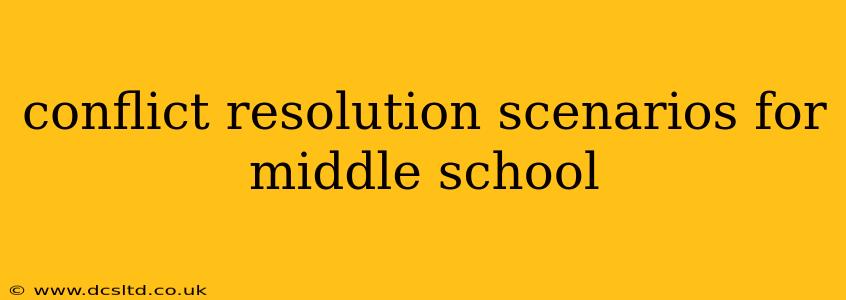Middle school is a crucible of social and emotional development. Navigating friendships, academic pressures, and burgeoning independence often leads to conflict. Equipping students with effective conflict resolution skills is crucial for their well-being and success. This article presents several conflict resolution scenarios for middle school, exploring different approaches and highlighting key learning points. We'll also address frequently asked questions regarding conflict resolution in this age group.
Common Middle School Conflicts: Setting the Stage
Before diving into specific scenarios, let's acknowledge the common types of conflicts middle schoolers face:
- Friendship Disputes: Betrayal, exclusion, rumors, disagreements over activities or friends.
- Bullying/Cyberbullying: Verbal, physical, or online harassment.
- Academic Competition: Grade envy, cheating accusations, collaborative project disagreements.
- Classroom Conflicts: Disagreements with teachers, disruptive classmates, resource allocation issues.
- Social Media Conflicts: Online arguments, inappropriate posts, spreading gossip.
Scenario 1: The Stolen Phone
Situation: Maya accuses Liam of stealing her phone. Liam denies it, and both students are adamant. Tensions are high, and other students are getting involved.
Conflict Resolution Steps:
- Separate and Calm: A teacher or counselor should separate Maya and Liam to allow them to calm down before discussing the situation.
- Active Listening: Each student should have a chance to explain their perspective without interruption. Focus on understanding their feelings and concerns.
- Fact-Finding: Explore the timeline of events. Where was the phone last seen? Who had access to the area? Were there any witnesses?
- Brainstorm Solutions: If the phone is found, discuss ways to prevent this from happening again. If it remains missing, explore options like contacting school security or parents.
- Mediation: If necessary, a neutral third party can mediate the conversation to ensure both sides feel heard and understood.
Scenario 2: The Cheating Accusation
Situation: Sarah suspects Ben cheated on a math test. She's hesitant to report him, fearing social repercussions.
Conflict Resolution Steps:
- Address Sarah's Concerns: Acknowledge her fears and validate her feelings. Explain the importance of academic honesty.
- Discuss Options: She could talk to Ben privately, explaining her concerns and giving him a chance to clarify. She could also speak to the teacher discreetly, outlining her observations.
- Focus on the Behavior, Not the Person: Emphasize that addressing cheating isn't about targeting Ben but about upholding fair practices.
- Confidentiality: Assure Sarah that her concerns will be handled sensitively and confidentially.
Scenario 3: The Cyberbullying Incident
Situation: A group chat is spreading hurtful rumors and images about Emily.
Conflict Resolution Steps:
- Document the Evidence: Screenshots of the messages or posts should be saved as evidence.
- Report to Authorities: Emily should report the incident to school administrators, parents, and possibly the social media platform involved.
- Support and Counseling: Emily needs support and counseling to cope with the emotional impact of cyberbullying.
- Restorative Justice: In some cases, restorative justice practices might be implemented, involving the bullies in a process to understand the harm caused and make amends.
H2: What are some conflict resolution strategies for middle schoolers?
Several strategies prove effective in resolving conflicts among middle schoolers. These include negotiation, compromise, mediation, and restorative justice. Negotiation involves both parties discussing the issue and finding a mutually agreeable solution. Compromise requires each party to give up something to reach a resolution. Mediation utilizes a neutral third party to facilitate communication and guide the resolution process. Restorative justice focuses on repairing the harm caused by the conflict and involves all parties in finding a solution that addresses everyone’s needs.
H2: How can I teach my child conflict resolution skills?
Teaching your child conflict resolution skills is an ongoing process that starts at home. Start by modeling healthy conflict resolution in your own interactions. Teach your child to identify their feelings, listen actively to others' perspectives, and brainstorm solutions collaboratively. Role-playing conflict scenarios can be a fun and effective way to practice these skills. Encourage empathy and perspective-taking. Help your child develop assertiveness skills to express their needs and opinions respectfully.
H2: What are some common causes of conflict in middle school?
Conflicts in middle school frequently stem from social dynamics, academic pressures, and developmental changes. Peer pressure, competition for status, and disagreements over friendships are common. Academic challenges, such as test anxiety or difficulty with coursework, can also lead to conflict. Hormonal changes and the search for identity can increase emotional volatility, making conflict more likely.
Conclusion
Middle school presents unique challenges in conflict resolution. By understanding the common conflicts, employing effective strategies, and providing support, educators, parents, and students can create a more positive and productive learning environment. Remember, teaching conflict resolution skills is an investment in the emotional intelligence and well-being of young people.
